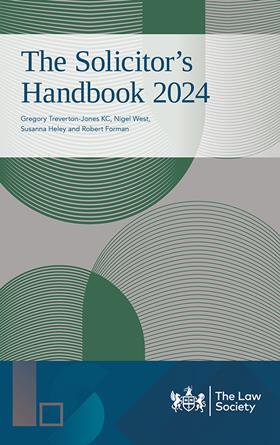Guidance for our times
The Solicitor’s Handbook 2024
Gregory Treverton-Jones KC, Nigel West, Susanna Heley and Robert Forman
£110, the Law Society
★★★★★
This outstanding book should be available to all compliance officers for legal practice, managing partners and chief executives in every law firm in England and Wales. It will aid each of those audiences when issues arise in relation to the SRA Standards and Regulations 2019, consisting of not just the SRA Principles, and the Codes of Conduct for solicitors and firms, but also wider authorisation insurance and financial services rules.
My experience as an adviser to firms is that, as a firm subtly evolves over time, regulatory filings should do so too. But these can be easily overlooked. This book reduces that risk.
There is clear and comprehensive coverage of the rules that relate to a solicitor’s practice, including the SRA Accounts Rules. Guidance on the role of COLPs and COFAs is particularly useful.
As the authors note, since the previous 2022 edition there has been an increased concentration by the SRA on matters that fall outside the solicitor/client relationship, such as sexual misconduct, toxic workplaces and inappropriate use of social media. The entering into the employer/employee relationship is possibly a fool’s errand by the SRA. It will require increased resources. And unrealistic expectations are likely to create a sense of disappointment with the SRA itself. As the SRA seeks a wider remit and ever greater powers, the very negative approach to regulation is damaging both to the reputation of the solicitors’ profession and also to legal professions generally in England and Wales. It is also detrimental to our collective reputation as a global place to do legal business, which puts at risk our position as a country whose legal professionals can be trusted.

This book helps to manage regulatory risks. Every firm gets things wrong. If you do thousands of tasks daily some will be perfect, some good enough, some well-intended but suboptimal, and hopefully a very small percentage will be wrong in hindsight. This book helps those managing law firms ensure that they know the regulatory framework, understand it practically, and can give their firm the best chance of success in a system designed to retrospectively judge decision-making under the SRA’s 2019 regime.
Law firms face a range of risks. These encompass regulation, professional indemnity costs, complaints-handling, financial services provision, unregulated competitors, and external investment. All these topics are covered well in this book. But there are also wider risks, including leadership, supervision, training of staff, business development, financing growth, technology and evolving client expectations, all of which are one step removed (or more) from the regulatory framework covered in this book.
It is important to demonstrate excellence in terms of the expectations of a regulator that is seeking to re-establish its remit on a wider basis.
It would be a foolhardy leader, manager or compliance officer who does not have a copy of this book.
Paul Bennett is a partner at Bennett Briegal LLP and chair of the Law Society’s Leadership and Management Section Committee
The Solicitor’s Handbook 2024
★★★★✩
Having reviewed a number of editions of this book, I always have to remind myself that I am reviewing the book, not the subject. But one cannot help wondering if we are over-regulated, and what guidance and support are available. Other respected professions have trade union-like support from their professional bodies. And their clients or patients are more limited in the type of complaints their regulator would investigate.
This guide is extremely useful to refer to, not only when a solicitor is facing a crisis, but also when reading for general interest about the profession. It is also handy as a sourcebook for the internal office training we should offer colleagues, especially on such vital issues as money laundering and other risk scenarios. Solicitors are targets for criminals.
Professional guidance and standards are always developing. To an extent, they are a reaction to events and changing expectations of clients. Gone are the days when guidance was contained in a short booklet, distributed free of charge up until the late 1990s. Regulation and standards are now complex.
Much has changed since the last edition two years ago. An area of increasing significance is how the profession deals with behaviour that is neither connected to the solicitor-client relationship nor always office-based. How far should private lives be regulated? The SRA enforcement strategy explains its approach but there will no doubt be issues over who regulates what and when. A professional person might face multiple investigations relating to the same incident, all with different approaches, burdens and standards of proof and costs rules.
There are some important changes in this edition. The chapters dealing with the SRA Code of Conduct have been rewritten to ensure that the relevant provisions are easy to access. There is a new chapter on economic crime prevention; guidance on SLAPPs and improper use of litigation; and updated guidance on the SRA’s new fining regime and powers of investigation. There is also updated guidance on the circumstances when firms can make payment for their costs from money in client account, and also guidance on the principles which steer the Solicitors Disciplinary Tribunal, especially when the SRA has brought an unsuccessful prosecution.
The public rightly expects us to have extremely high standards. We can no longer rely simply on a sixth sense to identify issues. This book is accessible, comprehensive and authoritative.
David Pickup is a partner at Pickup & Scott Solicitors, Aylesbury





























No comments yet